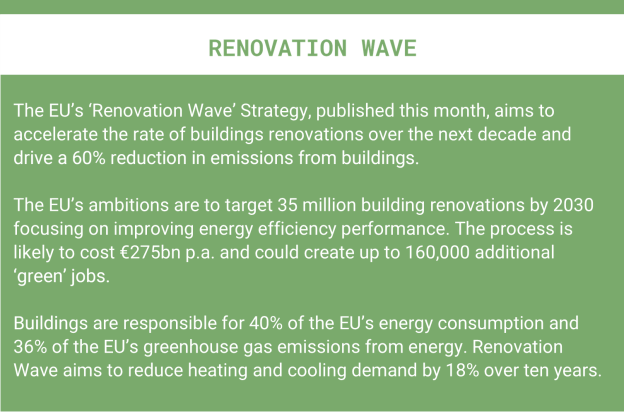
PARTNER CONTENT by GRAVIS
This content was paid for and produced by GRAVIS
Eliminating energy wastage is an increasingly important focus for governments and corporations, forming a key consideration in the transition to a low carbon economy. The concept, typically referred to as Energy Efficiency, can deliver a variety of benefits including reductions in; greenhouse gas emissions, the need for energy imports and energy-related costs. Energy efficiency has been dubbed the third pillar of infrastructure investment and it is a rapidly growing sub-sector of the global infrastructure market, complementing the ongoing build-out of renewable energy generation capacity.
The opportunities to improve energy efficiency are vast and span all areas of the economy, from increasing the performance of buildings, to improving efficiencies within energy generation and distribution, or efficiencies linked to transportation and industrial/agricultural production. Sustainable Development Capital estimates up to 75% of the original energy resource is lost through the generation, transmission & distribution, and end usage. Meanwhile, the International Renewable Energy Agency forecasts that of the $120tn of global energy sector investment required to achieve the ambitions of the Paris Climate Accord, 44% will need to be directed towards energy efficiency.

Buildings: According to the International Energy Agency, buildings were responsible for 28% of global energy-related CO2 emissions in 2019, while buildings and the building construction sector combined were responsible for over a third of global final energy consumption – the majority consumed by residential buildings. Space cooling and heating requirements, increased use of appliances, reliance on fossil-fuel based heat and power provision, and insufficient regulation of sustainability and energy efficiency requirements, have all contributed. As a result, buildings offer huge potential for improvement and a reduction in emissions.
Simple policies, such as the replacement of incandescent and halogen lamps with LED lighting, can drive efficiency. Improvements in ‘building envelopes’ – the components of a building’s structure such as insulation, window materials and air sealing – can be significant and the majority of energy-related investment in buildings is being directed here.
Decreased reliance on fossil fuel-based heating technologies will be a key to reducing emissions. For example, moving away from natural gas boiler systems to heat pumps (which can also provide a cooling function). Whilst in the UK and across the Northeast US commercial and residential properties are highly reliant on natural gas-based central heating systems, with very limited penetration of heat pumps or electric heating systems, in Sweden, domestic heating requirements are provided for by heat pumps, electric heating systems, and most significantly; district heating networks (see below). Reliance on fossil fuel heating systems is largely non-existent.
Energy Generation & Distribution: In many developed economies, such as the UK, incumbent power networks are centralised and inefficient. Electricity is generated at very large-scale facilities generally in remote locations. They are typically connected to a network of high-voltage transmission lines before being distributed at far lower voltage to dispersed end users. During this process there is significant wastage: much of the energy content of fossil fuels is wasted in the process of power generation, conversion losses, and transmission losses as the power is distributed across long distances.
A more efficient (and less polluting) energy network for the future is a decentralised one, with energy generated at smaller-scale facilities, such as combined heat and power plants or smaller scale renewables, away from the main grid. Decentralised networks can serve individual buildings or whole cities, and will reduce inefficiencies associated with centralised networks, carbon emissions, and energy costs in the medium to long-term.
Example: District Heating Network

District heating plants provide higher efficiencies, lower costs, and better pollution control than localised boilers, reducing carbon emissions. Heat generation accounts for approximately a third of the UK’s carbon emissions. The UK government has established a £320m investment programme to help deliver more district heat networks alongside the private sector, which may introduce an additional £1bn of investment.
Transportation: The transport sector has the highest final energy consumption of all sectors and relies on fossil fuels, making it a major source of greenhouse gas emissions. In terms of efficiency, the opportunity comes from the lower cost (over time) of alternatives such as electric vehicles (EVs) vs. conventional petrol/diesel vehicles, where the cost of electric charge over 100 miles may be 75% cheaper than petrol. The electrification of transport using batteries (and hybrid solutions), alongside renewable energy generation technologies, is an option for rail and light-duty road transport (i.e. cars, buses, and smaller HGVs). A shift toward EVs requires considerable investment in networks of public charging points, an emerging an investible area within the energy efficiency infrastructure theme.
Notwithstanding tougher regulations from central policy-makers relating to energy efficiency requirements in buildings or emission reduction targets, corporate entities and local authorities are incentivised to undertake energy efficiency initiatives with cost savings and sustainability ambitions (an increasingly important aspect of corporate strategy). There is scope for the private sector to inject capital into projects that generate returns linked to the savings delivered to the end client or can simply be structured for the provision of long-term capital. Energy efficiency projects typically attract long-term, infrastructure-like cash flows and in the prevailing environment such opportunities are likely to be highly sought after.
The VT Gravis Clean Energy Income Fund has identified investable opportunities within the global energy efficiency sector, through publicly listed companies. These entities provide exposure to diversified portfolios of energy efficiency projects which typically attract long-dated, availability-based cash flows to the investor while providing cost and emissions benefits to counterparties.
William Argent, Director
Fund Adviser, VT Gravis Clean Energy Income Fund
Find out more

Related Content







